If you’ve ever felt like your brilliant LinkedIn post didn’t get the engagement it deserved, you’re not alone.
It’s frustrating.
But the truth is, the content you create is only half the battle; the other, more critical half is when you hit ‘post’.
Short Summary
- The best time to post on LinkedIn for engagement varies significantly by location, reflecting regional work habits and engagement trends.
- Generally, weekday mornings (especially Tuesdays through Thursdays) drive the highest engagement across most regions.
- Analyzing audience behavior and leveraging LinkedIn analytics is essential for identifying personalized, optimal posting schedules.
- Time zones must be carefully considered, especially for businesses with a global or multi-regional audience.
- Tools like Social Champ streamline the process, enabling automated scheduling, intelligent timing suggestions, and detailed performance insights.
The classic rules still hold: we consistently find that peak engagement happens during those mid-morning and midday sweet spots on weekdays.
This is the time when professionals are actively catching up on industry news.
In this ultimate guide, we don’t stop at the general best times.
We’ll break down the proven strategies to maximize your visibility but also give you industry-specific posting schedules (yes, finance pros scroll at different times than marketers!).
Finally, we’ll show you how to truly personalize this data to find your unique best time and utilize a LinkedIn scheduler to truly excel at this professional platform.
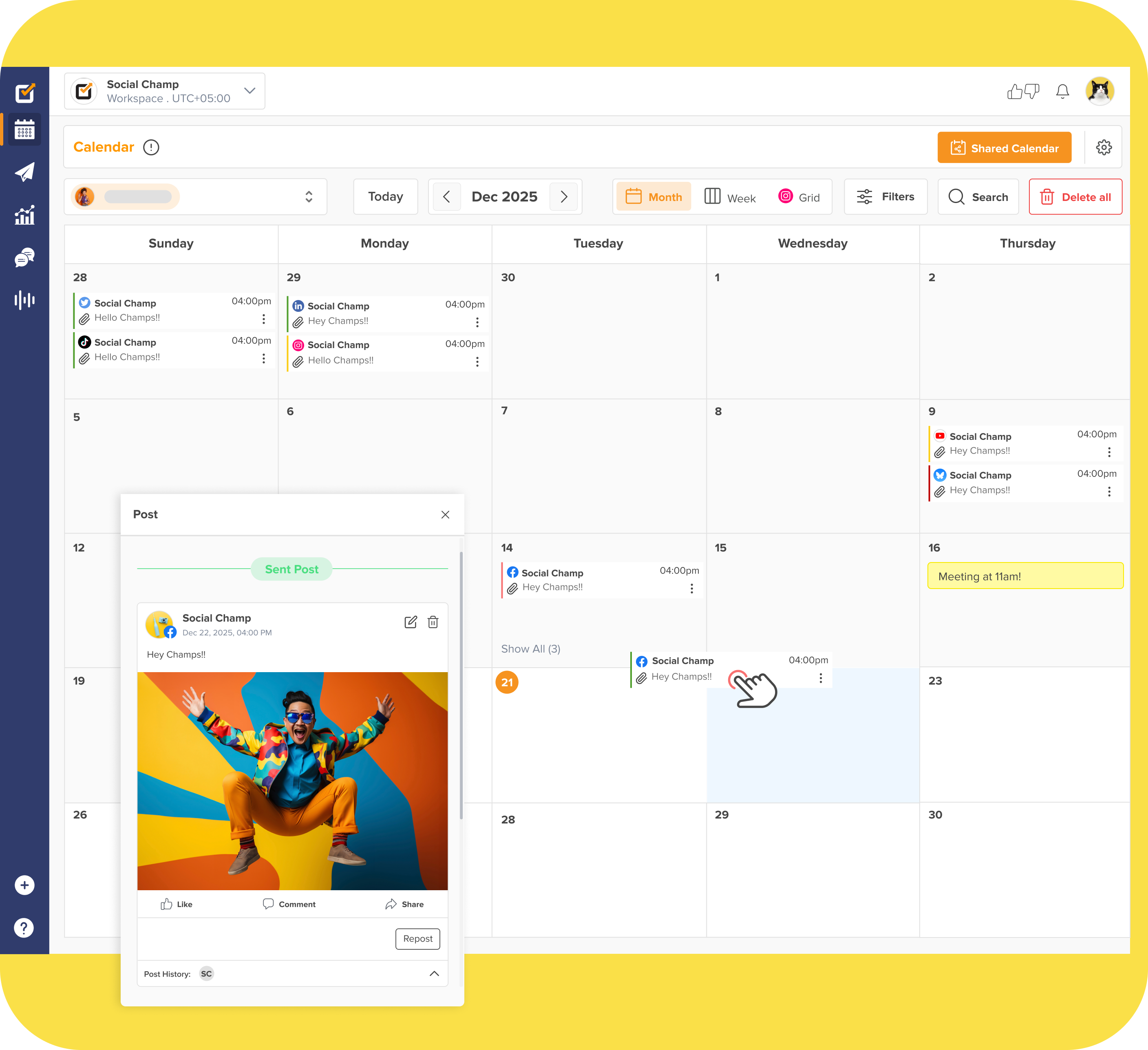
Time Is Money— Are You Using It Wisely?
Why guess when you can know? Let Social Champ’s Best Time to Post feature boost your engagement. Start scheduling smarter!
Best Time to Post on LinkedIn: Global Trends for 2026
The best time to post on LinkedIn for engagement generally depends on your audience, but a few studies have shown that your content might perform better at certain time slots.
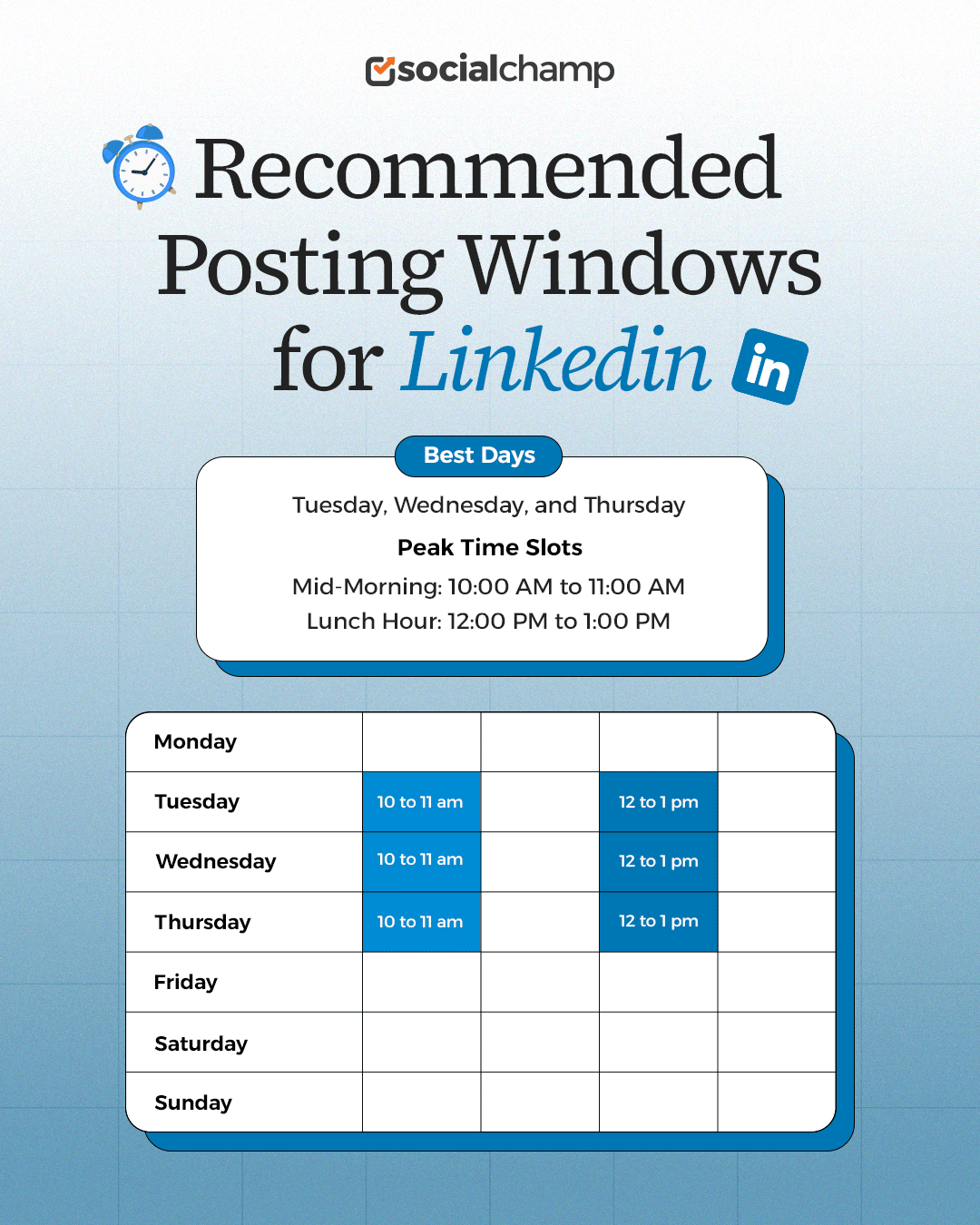
Overall Engagement Findings: Mid-Week Peak
Overall findings consistently show that LinkedIn, as a professional networking platform, sees its highest engagement during the core business hours of the workweek.
The peak activity is generally concentrated from mid-morning to early afternoon (roughly 9:00 AM to 2:00 PM local time).
This trend is attributed to professionals checking the platform before diving into their workday, during coffee breaks, and most significantly, over their lunch break.
Approximately 80% of all LinkedIn engagement occurs during standard business hours (9:00 AM to 5:00 PM).
Recommended Posting Windows
The most effective posting windows are strongly centered on the middle of the week, with slight variations by study:
- Best Days: Tuesday, Wednesday, and Thursday are consistently identified as the best days for high engagement.
- Peak Time Slots: While the overall window is 9:00 AM to 2:00 PM, the most common peak engagement times are around:
- Mid-Morning: 10:00 AM to 11:00 AM
- Lunch Hour: 12:00 PM to 1:00 PM
Posting during these times significantly increases the chance of catching your audience when they are active and receptive to professional content.
Low Engagement on Weekends
Weekends, specifically Saturdays and Sundays, generally see significantly lower engagement on LinkedIn. This is because:
- Platform Context: LinkedIn is primarily viewed as a work-related platform. Most professionals use the weekend as a time to disconnect from work, career, and industry-related content.
- User Behavior: When users are off work, they tend to spend time on more leisure-focused social media platforms (like Instagram or TikTok), resulting in a sharp drop in activity on LinkedIn. The reduced traffic, as well as the lower user intent to engage with professional content, leads to a lower return on posts made during this time.
Featured Article: Facebook Ads for Real Estate: Proven Strategies, Success Stories, and Expert Tips for 2025
Best Time to Post on LinkedIn by Day (Data-Driven Schedule)
Based on recent studies, the most effective posting window is generally Tuesday through Thursday, between 9 AM and 2 PM (Local Time).
However, slight variations by day can optimize your reach for specific moments in the workweek.
Our Recommended Data-Driven Posting Schedule (Local Time)
The following table summarizes the key daily windows that consistently show high engagement across multiple data sources.
However, you should also use your own analytics to test and confirm these times for your specific audience’s time zone and behavior.
| Day | Best Time to Post (General Audience) | Rationale |
|---|---|---|
| Monday | 10:00 AM – 1:00 PM | Professionals are easing into the workweek; aim for the late morning to early afternoon to catch them after initial meetings. |
| Tuesday | 9:00 AM – 12:00 PM | The highest engagement day. Catching users as they start their main work tasks and take mid-morning breaks. |
| Wednesday | 10:00 AM – 2:00 PM | Peak day alongside Tuesday. Strongest engagement window, particularly around lunchtime. |
| Thursday | 9:00 AM – 1:00 PM | Strong mid-week engagement; capitalize on morning and lunch activity before the weekend focus begins. |
| Friday | 10:00 AM – 11:00 AM | Engagement tapers off quickly; focus on a brief mid-morning window before the weekend mindset takes over. |
| Saturday | 9:00 AM – 11:00 AM | Generally low engagement, but an early morning test can reach professionals catching up when competition is low. |
| Sunday | 7:00 AM – 9:00 AM | Very low activity; try an early morning slot to catch the few users preparing for the week ahead. |

While You Sleep, Others Post — and Win!
Consistency builds trust (and revenue). Social Champ keeps your content calendar full — even when you’re offline.
-
Prime Time for Engagement
Based on recent data, the best time of day to post on LinkedIn for optimal reach and engagement falls between 10am to 12pm and 1pm to 4pm, particularly on Tuesdays, Wednesdays, and Thursdays.
These hours coincide with key moments during the workday when professionals are either starting to focus on their tasks or taking breaks to check LinkedIn.
This is the time when users are most likely to scroll through their feeds, engage with posts, and take action like liking, commenting, or sharing.
Posting during these windows is a good way to capitalize on moments when LinkedIn’s algorithm is most likely to favor your content.
The idea is simple: if your post catches attention in the first hour or so, it gains momentum, appearing higher in people’s feeds and reaching a wider audience.
-
Best Times for Company Pages
For companies and organizations managing a LinkedIn presence, the best time to post is slightly more specific.
Company Pages tend to see the best results on Tuesdays, Wednesdays, and Thursdays, particularly from 10am to the next one to three hours.
These hours line up with when users are most likely to engage with brand-related content or professional updates that align with their work schedules.
When posting for a company page, you want to make sure that your content is timely and aligns with the professional routines of your audience.
Since professionals use LinkedIn to stay updated on industry trends, job opportunities, and professional insights, your posts need to appear when people are actively looking for this kind of content.
-
Engaging During Peak Hours
While posting between 10 a.m. and 12 p.m. and 1 p.m. to 4 p.m. on weekdays is a general sweet spot for high engagement, it’s important to remember that 7am to 4pm is another prime range for LinkedIn activity.
These hours cover the workday from the moment people start checking their feeds to the times when they might be winding down their day or taking short breaks.
However, posting at the very beginning of the day, between 7am and 9am, is usually not as effective as the mid-morning and afternoon windows, which tend to see higher user engagement levels.
The engagement patterns for high-performing posts show that content shared at 10 a.m. and 11 a.m. on Tuesdays and Thursdays consistently performs well.
These are the times when professionals are typically deep into their workday and looking for insightful content or updates to engage with.
A thought-leadership piece, an industry update, or a personal accomplishment, posts made during these key hours stand a better chance of generating discussions and attracting valuable attention.
Featured Article: 100+ Twitter Bio Ideas to Strengthen Your Impression in 2025
Best Days to Post on LinkedIn by Industry
Each sector’s audience engages differently, depending on work patterns and content consumption habits.
Aligning your LinkedIn posting schedule with these industry-specific windows ensures your content is delivered when your audience is most receptive, enhancing the likelihood of interaction, shares, and lead generation.
| Industry | Best Posting Days | Optimal Posting Times (Local Time) | Key Rationale |
|---|---|---|---|
| Technology and Software | Tuesday to Thursday | 9:00 AM – 11:00 AM | Catching early-rising professionals during their mid-morning engagement. |
| Healthcare and Pharmaceuticals | Wednesday, Thursday | 8:00 AM – 10:00 AM (Wed) 2:00 PM – 4:00 PM (Thu) | Aligns with their structured early mornings and mid-afternoon breaks. |
| Finance and Banking | Tuesday and Wednesday | 7:00 AM – 11:00 AM | Captures the attention of the fast-paced finance sector during their early peak hours. |
| Education and Nonprofits | Monday and Wednesday | 10:00 AM – 12:00 PM | Targets late morning engagement that fits around educators’ and nonprofit workers’ schedules. |
| Marketing and Advertising | Tuesday to Thursday | 9:00 AM – 12:00 PM | Active mid-morning to early afternoon hours for marketing professionals. |
| Manufacturing and Construction | Tuesday and Wednesday | 8:00 AM – 9:00 AM | Reaches professionals as they begin their workday. |
| Retail and E-commerce | Wednesday | 9:00 AM – 11:00 AM | Prime mid-morning engagement window. |
| Human Resources and Recruitment | Tuesday and Thursday | 10:00 AM – 12:00 PM | Captures HR professionals and recruiters during their late morning activity. |
| Legal and Consulting | Tuesday and Thursday | 9:00 AM – 11:00 AM | Mid-morning hours align with the work schedules of legal and consulting professionals. |
| Travel and Hospitality | Tuesday to Thursday | 10:00 AM – 4:00 PM | Professionals in this sector are active across a broad, sustained window during the core workday. |

The Algorithm Won’t Wait — Why Are You?
Timing is everything. Schedule smarter, post faster, and ride every trend before it fades with Social Champ. Your audience is scrolling now.
-
Technology and Software
Best Posting Times: Tuesday to Thursday, 9:00 AM – 11:00 AM
Professionals in the tech industry are often early risers, engaging with content during mid-morning hours.
Posting between 9:00 AM and 11:00 AM on weekdays ensures your content reaches them when they’re most active.
-
Healthcare and Pharmaceuticals
Best Posting Times: Wednesday, 8:00 AM – 10:00 AM and Thursday, 2:00 PM – 4:00 PM
Healthcare professionals typically have structured schedules.
Engaging them during early mornings and mid-afternoons on Wednesdays and Thursdays aligns with their routines, increasing the likelihood of interaction.
-
Finance and Banking
Optimal Posting Times: Tuesdays and Wednesdays, 7:00 AM – 11:00 AM
The finance sector is fast-paced, with professionals often starting their day early.
Posting between 7:00 AM and 11:00 AM on Tuesdays and Wednesdays captures their attention during peak engagement hours.
-
Education and Nonprofits
Best Posting Times: Monday and Wednesday, 10:00 AM – 12:00 PM
Educators and nonprofit workers engage with LinkedIn during late mornings on Mondays and Wednesdays.
This timing aligns with their schedules, making them more receptive to content.
-
Marketing and Advertising
Optimal Posting Times: Tuesday to Thursday, 9:00 AM – 12:00 PM
Marketing professionals are active during mid-morning to early afternoon hours on weekdays.
Posting between 9:00 AM and 12:00 PM ensures your content reaches them when they’re most engaged.
-
Manufacturing and Construction
Optimal Posting Times: Tuesday and Wednesday, 8:00 AM – 9:00 AM
Early mornings on Tuesdays and Wednesdays are ideal for reaching professionals in the manufacturing and construction sectors, as they begin their workday.
-
Retail and E-commerce
Best Time to Post: Wednesday, 9:00 AM – 11:00 AM
Mid-morning on Wednesdays is a prime time to engage retail and e-commerce professionals, who are active during these hours.
-
Human Resources and Recruitment
Best Time to Post: Tuesday and Thursday, 10:00 AM – 12:00 PM
HR professionals and recruiters are most active during late mornings on Tuesdays and Thursdays, making it an optimal time to post.
-
Legal and Consulting
Optimal Posting Times: Tuesday and Thursday, 9:00 AM – 11:00 AM
Legal and consulting professionals engage with LinkedIn during mid-morning hours on Tuesdays and Thursdays, aligning with their work schedules.
-
Travel and Hospitality
Best Posting Times: Tuesday to Thursday, 10:00 AM – 4:00 PM
Professionals in the travel and hospitality industry are active throughout the day on weekdays, with peak engagement between 10:00 AM and 4:00 PM.
Best Time of Day to Post on LinkedIn by Regions, Locations & Time Zones
LinkedIn’s global footprint offers businesses a unique opportunity to connect with professionals across diverse regions.
However, audience engagement patterns vary significantly depending on geographic location.
Posting at optimal times for each region can dramatically enhance your visibility, making timing a strategic element of LinkedIn marketing.
Regional Examples of Best Posting Times
- United States (EST)
In the U.S., LinkedIn users are most active between 7am and 11am, especially midweek. Morning hours align with the start of the workday when professionals catch up on updates before diving into meetings. Thursdays see particularly high engagement, especially around 9am and 12pm. - United Kingdom (WET)In the UK, activity peaks slightly later in the morning. Ideal posting times fall between 8am and 1pm, with Thursdays from 8am to 10am being especially productive. This mid-morning window captures professionals during planning or networking moments early in the day.
- Australia (AEST)Australian LinkedIn users show consistent engagement from 8am to 2pm, Monday through Friday. Mornings (especially 10am) tend to be the sweet spot, capturing both the daily planning phase and lunchtime browsing.
- Canada (EST)Similar to its southern neighbor, Canada’s best engagement falls between 5am and 11am on weekdays. Interestingly, there’s also a late-night engagement bump around 9–11pm, possibly driven by professionals reviewing content after work.
- Germany and France (CET)Across much of Western Europe—including Germany and France—the best time of day to post on LinkedIn is typically 9am to 12pm, with another spike around 4–5pm Thursdays again tops the charts, with 7pm CET proving especially fruitful for engagement.
- Nigeria and South Africa (WAT/SAST)In Africa’s more active LinkedIn regions, midday engagement (between 10am and 4pm) is common, especially from Monday to Friday. In Nigeria, Thursday again emerges as a peak day, while South African users tend to engage more from 12pm to 6pm.
- Philippines (PHT)In Southeast Asia, user behavior reflects more late-day engagement. In the Philippines, 6pm to 10pm is a hotspot, aligning with post-work relaxation and professional check-ins. Tuesdays and Thursdays are particularly active evenings.
When Is the Best Time to Post on LinkedIn, Depending on Time Zones
Understanding how engagement shifts by time zone adds another layer of strategic planning:
- CET: High activity on Thursdays at 7pm.
- EST: Peak times include 5am Tuesday and 6am/5pm Thursday
- GMT: Best engagement from 7am to 9am on Thursdays
- MST: Engagement rises around 5am and 3pm
- PST: Thursdays and Fridays, see activity from 2pm to 4pm

Stop Managing Social Media. Start Mastering It.
You’ve outgrown spreadsheets. With Social Champ, one dashboard powers every post, platform, and performance insight you need.
Factors That Influence the Best Time to Post on LinkedIn
The optimal time to post on LinkedIn is a moving target, often shaped by the platform’s algorithm, audience demographics, and the rhythms of the global workday and business calendar.
LinkedIn’s Algorithm: Prioritizing Engagement Signals
The LinkedIn algorithm functions to keep users on the platform longer by prioritizing relevant and valuable professional content.
When determining which posts to push out to a wider audience, the algorithm relies heavily on engagement signals received during the post’s crucial initial phase. This is often referred to as the “golden hour” (the first 60 minutes).
| Engagement Signal | Prioritization | Rationale |
|---|---|---|
| Comments | Highest Priority | A thoughtful comment signals that a meaningful conversation is happening. The algorithm views this as high-quality interaction and will boost the post to second and third-degree connections. Replies to comments also extend the post’s lifespan. |
| Reshares/Reposts | High Priority | A reshare, especially one with added commentary, indicates the content is highly valuable and signals the author’s strong credibility to a new network. |
| Reactions (Likes, etc.) | Medium Priority | While positive, simple reactions are easier to gain and are generally weighted less than comments. However, a high volume of responses in the initial phase is still a strong positive signal. |
| Dwell Time | High Priority | This refers to how long a user spends actively reading or engaging with a post (like scrolling through a carousel document). Longer dwell time suggests the content is compelling and high-quality. |
| Native Content | Boosted Reach | The algorithm favors content that keeps users on LinkedIn, such as text posts, native videos, or document carousels. Posts that include external links (especially in the main body) are often deprioritized. |
Demographic Factors Shaping User Activity
When users log on is not random; it is highly predictable based on their professional profiles. Tailoring your post time to your target audience’s routine is essential.
| Demographic Factor | Influence on Login Time | Strategic Posting Insight |
|---|---|---|
| Job Roles & Industry | Different industries have different workday peaks. For example, Finance professionals are often early birds (logging on around 7:00 AM). At the same time, HR and Marketing roles are more active mid-morning (9:00 AM – 12:00 PM) when they are settled into strategic tasks. | Post during the specific, established peak times for your target industry. |
| Seniority Level | C-suite/Senior Executives may check LinkedIn briefly first thing in the morning or late evening. Mid-level managers are often active during work breaks, and Entry-level professionals may check more sporadically throughout the day. | Content for executives performs well early morning. Content for mid-level staff aligns well with typical break times. |
| Geographical Location | This is the most critical demographic factor for timing. A post will only reach a user if they are online in their local time zone. | ALWAYS post according to your audience’s local time zone, not your own. If your audience is global, you must segment your posts or choose times that hit the maximum overlap of major time zones (e.g., 9:00 AM EST and 2:00 PM GMT). |
Workday Routines and Seasonal Factors
Engagement on LinkedIn follows the predictable cycles of the professional world, from daily breaks to the annual business calendar.
Workday Routines
- Pre-Work/Early Morning (7:00 AM – 9:00 AM): Many professionals check their feed while having their first coffee or commuting. This is a key time to catch them before deep work starts.
- Mid-Morning (10:00 AM – 11:00 AM): Considered the peak engagement window across many sectors, as users take a short mental break between meetings or tasks.
- Lunch Break (12:00 PM – 1:00 PM): A predictable spike in activity as users step away from their desks and check social media.
- Mid-Afternoon (3:00 PM – 4:00 PM): A second, smaller peak as professionals look for a break or start winding down and catching up before the end of the day.
Seasonal and Business Factors
- Mid-Week Momentum: The days from Tuesday to Thursday consistently outperform Mondays (when people are catching up on email/meetings) and Fridays (when they are checked out for the weekend).
- Seasonal Slowdowns: Activity typically decreases during major holiday weeks (like the week between Christmas and New Year’s) and often sees a slump during the summer vacation months.
- Fiscal Year End/Quarter Close: Posts related to planning, strategy, or results see a spike in relevance and engagement during periods of fiscal year end or quarter close (often late March, June, September, and December).
- Industry Conferences/Events: During a major industry conference, relevant content on LinkedIn can see a massive surge in engagement as attendees check the platform for updates, networking, and discussion.
Best Content Types to Post on LinkedIn
Buffer’s research consistently points to carousel (PDF/document) posts as the highest-performing content format on LinkedIn for engagement and reach.
- Engagement Rate: Carousels often achieve a significantly higher engagement rate. One analysis found they spark 278% more engagement than videos, 303% more than images, and a massive 596% more than text-only posts.
- Reshares: Document posts are also reported to be 2.5 times more likely to be reshared than other formats, signaling high perceived value.
While video posts are growing in popularity and often perform well (earning 5x the engagement of regular posts), the interactive, educational nature of carousels gives them a distinct advantage in the algorithm.
Why Carousels Encourage Longer Dwell Time
Carousels, uploaded as multi-page PDF documents, excel at increasing both dwell time (the amount of time a user spends on a post) and user interaction for the following reasons:
- Micro-Interaction: The act of swiping to view the next slide is a small, conscious interaction. Each swipe signals engagement to the LinkedIn algorithm, which then rewards the post with greater reach.
- Guided Narrative/Storytelling: Carousels break down complex ideas, step-by-step guides, or data into bite-sized, digestible slides. This narrative flow compels the reader to keep swiping until the end, transforming what might be a single, scroll-past text block into a mini-presentation.
- Higher Perceived Value: Because carousels often contain educational content, frameworks, or summaries, users are more likely to save or share them as a valuable resource or “mini-eBook,” further amplifying the post’s reach.
- Optimal for Scannability: They allow you to combine strong visuals (one per slide) with concise text, making the content easy to read and consume on a mobile device, which is where most LinkedIn engagement occurs.
The best LinkedIn strategy involves a balanced mix of content formats, with the format tailored to your specific goal:
| Content Format | Primary Goal | Recommended Use Cases | Best Practice Guidelines |
|---|---|---|---|
| Carousel (PDF/Document) | Highest Engagement & Thought Leadership | Step-by-step guides, “5 Ways to…” listicles, key takeaways from a report, process frameworks, or breaking down a complex concept. | Strong Hook on Slide one. Keep text concise per slide. Use a clear, high-contrast visual design. |
| Video | Building Personal Connection & Reach/Brand Awareness | Short “how-to” tutorials, personal updates, behind-the-scenes content, or quick insight-sharing from a leader. | Caption everything (most users watch on mute). Keep it short (ideally under 60 seconds). Post natively to LinkedIn, not a YouTube link. |
| Text Posts | Sparking Discussion & Consistency | Short opinion pieces, asking an open-ended question, sharing a recent failure/lesson, or summarizing a key idea in a conversational tone. | Use a strong hook in the first 2-3 lines. Use short paragraphs and white space to improve scannability. |
| Polls | Gathering Quick Audience Insights & Boosting Fast Interaction | Asking a professional or industry-relevant question to gauge preferences, industry trends, or common challenges. | Keep options clear and relevant. Ask questions that are genuinely useful for your business or thought leadership. |
| Articles (LinkedIn Publisher) | In-depth Expertise & SEO | Long-form analysis, detailed case studies, company news, or content you want indexed by search engines. | Use to deep-dive on a topic; it’s not for quick engagement. Use headers and images to break up the text. |
If you want to know more about how to make big on LinkedIn, we’ve covered everything including:
- LinkedIn trends
- How to post a video on LinkedIn?
- How to use LinkedIn?
- How to beat LinkedIn algorithm?
- What to post on LinkedIn?
- How often should you post on LinkedIn?
How to Determine Your Personal Best Time to Post on LinkedIn
Finding your personal best time to post on LinkedIn is essential for maximizing your content’s reach and engagement. While general best practice times exist, your unique audience may be active at different hours. This process requires systematic tracking and analysis using available tools.
-
Step-by-Step Guide Using LinkedIn Analytics
First, access your analytics by viewing:
- Company Page: Log in to LinkedIn, navigate to your Company Page, and click on the Analytics tab (often labeled “Content,” “Visitors,” “Followers,” etc.).
- Personal Profile: Go to your profile. Scroll down to your recent posts, and for each post, click on “View Analytics” or look for the section showing “Post Impressions” or “Views.” (Note: Personal profile analytics are less comprehensive than Company Page analytics, but they still provide post-level data).

LinkedIn Analytics
Locate Post Performance Data:
- In the Content/Posts section of your Company Page Analytics, or by checking individual post analytics for your profile, you will see a list of your content and its respective metrics.
Identify Key Metrics: Focus on tracking the following for each post:
- Posting Date and Time: Note the exact time (including time zone) your post went live.
- Impressions (or Views): The number of times your post was shown to LinkedIn members. This indicates reach.
- Reactions, Comments, and Shares: The core components of Engagement. These show the level of interaction and content resonance.
- Click-Through Rate (CTR): If your post included a link, this measures the percentage of people who clicked it.
Analyze Data for Patterns:
- Look at your highest-performing posts. Are they consistently published on a specific Day of the Week (e.g., Tuesday, Wednesday)?
- Examine the Time of Day for these top posts (e.g., 9:00 AM, 1:00 PM).
- Identify which content formats (e.g., text, image, video, document/carousel) perform best at these times.
Use Third-Party Tools (Optional): Many social media management platforms (like Social Champ, Buffer, Sprout Social, Hootsuite) offer more detailed reporting features that can automatically aggregate data, suggest optimal times based on your historical performance, and even help with scheduling.

Social Champ’s Analytics -
A/B Test Your Post Times
General recommendations are just a starting point. To find your peak time, you must A/B test by intentionally posting similar content at different times and days.
- Form a Hypothesis: Based on your initial analytics, choose two promising time slots, e.g., “Tuesday at 10 AM” (A) vs. “Thursday at 2 PM” (B).
- Isolate the Variable: For the test to be accurate, ensure the content quality and topic are as similar as possible. The only variable being tested should be the posting time.
- Run the Test: Post Content 1 at Time A, and an equally valuable piece of Content 2 at Time B. Repeat this over several weeks to collect statistically significant data, rotating the days.
- Track Key Metrics: Record and compare the following for all test posts:
- Impressions: Which time slot led to greater visibility?
- Engagement (Reactions + Comments + Shares): Which time generated the highest total engagement?
- Click-Through Rate (CTR): If applicable, which time drove more traffic off-platform?
- Determine the Winner: The time slot that consistently yields the highest combined results (high impressions and high engagement) is your current personal best time to post.

Consistency Isn’t Luck. It’s Social Champ!
Show up every day, without actually being there every day. Start your free trial now!
Frequency & Consistency: How Often Should You Post?
The optimal posting frequency on LinkedIn balances visibility with audience tolerance, prioritizing consistency and quality over sheer volume.
While research indicates that posting more often generally improves reach, there’s a “sweet spot” to avoid audience fatigue and ensure the quality of your content remains high.
Addressing Audience Fatigue and Reach
A common recommendation to avoid audience fatigue and maintain engagement is to post 2–5 times per week.
- Avoid Overwhelming Your Network: Unlike fast-paced platforms, LinkedIn’s professional audience tends to engage more selectively. Bombarding your network with multiple low-value posts daily can lead to unfollows or reduced engagement, which in turn signals to the algorithm that your content is not valuable.
- The Golden Rule: Consistency is King: The LinkedIn algorithm heavily rewards accounts that maintain a predictable and sustained posting pattern. Posting twice a week consistently will outperform daily posting daily for a week and then disappearing for a month.
Research-Backed Posting Suggestions
The ideal cadence differs based on whether you are managing a Company Page or a Personal Profile, as the algorithm favors individual thought leadership.
| Account Type | Recommended Frequency | Key Consideration |
|---|---|---|
| Personal Profiles | 2–5 times per week (typically once per business day) | Personal posts often receive 5× more engagement than Company Page posts. This frequency is a strong baseline for building individual thought leadership and network engagement. Consistency is vital. |
| Company Pages | 3–5 times per week | This frequency ensures a steady brand presence. Posts should focus more on company news, culture, product updates, and industry insights, often amplified by employee shares (employee advocacy). |
| High-Volume Strategy (Advanced) | 6–10 times per week | For established profiles/pages with a robust content pipeline, data suggests that posting this often can significantly accelerate reach and engagement. This is only sustainable if content quality is uncompromisingly high. |
Seasonal & Event‑Driven Strategies for LinkedIn Posting
For a successful LinkedIn posting strategy, timing your content around key seasonal and event-driven milestones is essential to maximize relevance and engagement.
Timing Posts Around Key Events
Strategically align your posts with events and calendar milestones relevant to your professional audience.
Industry Events (Conferences, Product Launches)
- Pre-Event Buzz (1-2 weeks before): Post to build anticipation. Share what you’re looking forward to, announce your participation (if applicable), or pose a question related to the event’s central theme. Use the official event hashtag.
- During the Event (Daily): Post live updates, key takeaways, interesting quotes from speakers, or photos with attendees/colleagues (with permission). This positions you or your company as an active, engaged member of the industry.
- Product Launches: Create a multi-phase campaign:
- Teaser Posts: Create curiosity with cryptic content or a countdown.
- Launch Day: Post the official announcement, product video, and a strong call-to-action (e.g., link to a demo or sign-up page).
- Follow-up: Share customer testimonials, deep-dive articles on features, or a Q&A video in the weeks following the launch.
Cultural/Religious Holidays (Ramadan, Christmas, Diwali, etc.)
- Be Thoughtful and Inclusive: LinkedIn is a professional platform, so posts should be respectful and relevant to a global workforce. Avoid overly promotional or religious content.
- Focus on Professional Themes:
- Thanksgiving/Christmas/Year-End: Focus on gratitude, end-of-year reflections, team highlights, community involvement, or holiday closures.
- Ramadan: Post content related to productivity tips during fasting hours, the value of reflection, or corporate social responsibility (CSR) initiatives.
- Diwali/Lunar New Year: Focus on themes of new beginnings, prosperity, or business growth.
- Timing: Schedule posts for the day of or slightly before to be timely. Be mindful of different time zones and how a global audience may observe these holidays.
Fiscal Calendar Milestones (End-of-Quarter/Year Updates)
- End-of-Quarter/Year: These are prime times for reporting on achievements and setting future goals.
- Share high-level business results, key client wins (“Rock Track” content), or thank-you posts acknowledging team performance.
- Post updates about company growth, new hires, or major strategic shifts. This content resonates well with investors, partners, and potential recruits.
- Beginning-of-Quarter/Year: Focus on thought leadership posts about market predictions, new strategic initiatives, or educational content to help your audience plan for the coming period.
Impact of Trending Topics and News Cycles
Trending topics and sudden news cycles can temporarily shift optimal posting windows and content focus.
| Effect | Explanation |
|---|---|
| Increased Engagement | A major industry announcement or a widely discussed piece of professional news can cause a surge of activity. Posting a timely, insightful comment on the topic can lead to high engagement, even if it’s outside your normal best posting time. |
| Timing Sensitivity | If a major event dominates the news cycle, such as a major political decision, natural disaster, or global economic shift), people may be more active online, but their focus may be distracted. Posting your standard content during such a high-intensity period might lead to lower visibility or, worse, appear insensitive. |
| Altering Best Times | While peak posting times are typically mid-morning to mid-afternoon on weekdays, a highly anticipated news event (like a major conference keynote or earnings call) at an off-peak time can create a temporary peak. Scheduling your relevant reaction or summary post immediately after that event can be highly effective. |
| Content Pivot | Flexibility is key. Be prepared to pause scheduled content that might seem trivial or tone-deaf and pivot to content that addresses or provides value related to the trending topic. Your post must add professional, constructive commentary—not just echo the news. |
Automate Your LinkedIn Posts With Social Champ
Consistent, timely content is the bedrock of a strong professional presence on LinkedIn.
However, manually posting at the ideal moment for your global audience is a relentless task.
This is where popular scheduling and analytics tools come into play.
Indispensable for marketing professionals and thought leaders, platforms like Social Champ offer a suite of features to streamline your social media workflows:
- Content Calendars: For visualizing and planning your entire content pipeline.
- Bulk Scheduling: To quickly queue up numerous posts in advance.
- Performance Analytics: To track key metrics like engagement, impressions, and clicks.
What Social Champ Offers
- Simplified Scheduling: Social Champ allows you to queue up a month’s worth of content in minutes.
- Optimal Timing: Crucially, it provides a feature to help you post at the optimal times, allowing you to schedule your posts at the exact time and day your audience is most likely to be engaged.
- Actionable Analytics: With its sophisticated analytics dashboard, you can effortlessly discover your personal best posting windows, the specific times when your audience is most active and engaged.
- Seamless LinkedIn Integration: Manage both your personal profile and company pages from a single, unified dashboard.
- Multi-Profile Management: The platform is built to manage multiple profiles and campaigns, perfect for agencies and growing businesses.
The ability to schedule posts at the optimal time is key to cutting through the noise and maximizing visibility.
This feature offers a clear, measurable advantage, as seen in the success of users like Bare Cybersecurity.
Here’s what Social Champ did for Bare Cybersecurity:
| The Challenge | The Solution | The Result |
|---|---|---|
| Limited resources and no dedicated marketing team. | Utilized Social Champ’s automated scheduling and AI-powered posting optimization (Best Time to Post). | Achieved a 35% higher engagement rate compared to competitors. |

Why Guess When You Can Be Sure of It?
Tap into data-driven posting times and elevate your LinkedIn strategy with Social Champ’s advanced analytics.
Conclusion
Identifying the best day and time to post on LinkedIn is a critical factor in maximizing the reach and effectiveness of your content strategy.
Whether you’re a recruiter targeting early risers, a tech brand aiming for peak midweek engagement, or a global business adjusting across time zones, timing plays a crucial role in how well your content performs.
While general trends offer a helpful starting point, the real value comes from testing, analyzing, and adjusting based on your unique data.
Tools like Social Champ can simplify this process by automatically identifying optimal posting times and scheduling your content accordingly, so you stay consistent without losing precious time.
Remember, LinkedIn rewards relevance and consistency.
Just by aligning your posts with when your audience is most active, you not only boost visibility but also build stronger, more meaningful engagement over time.
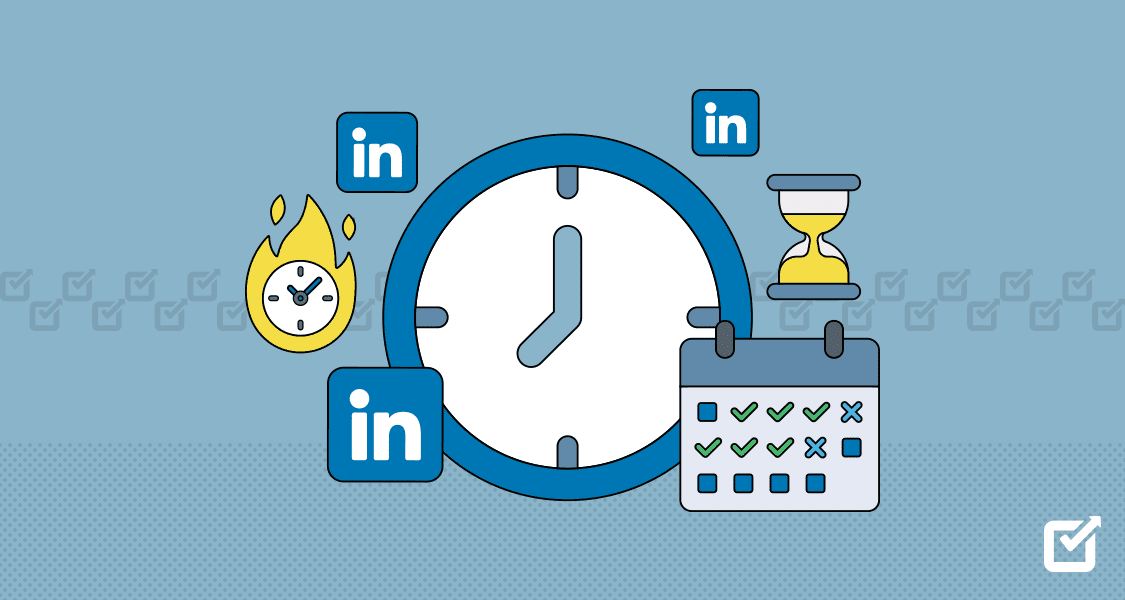
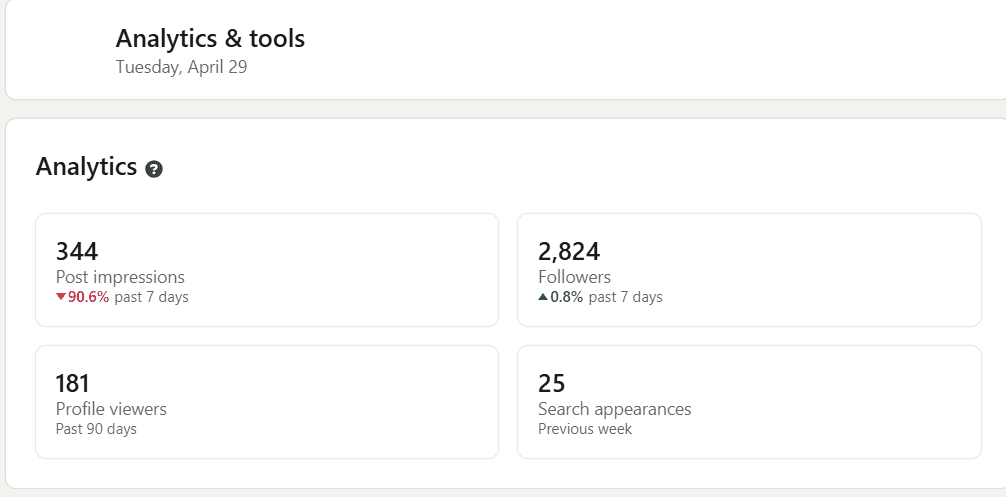
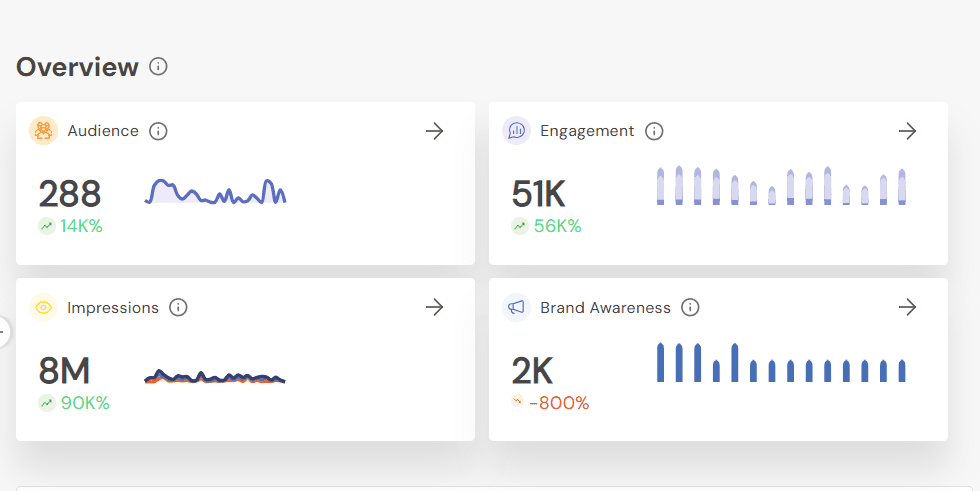


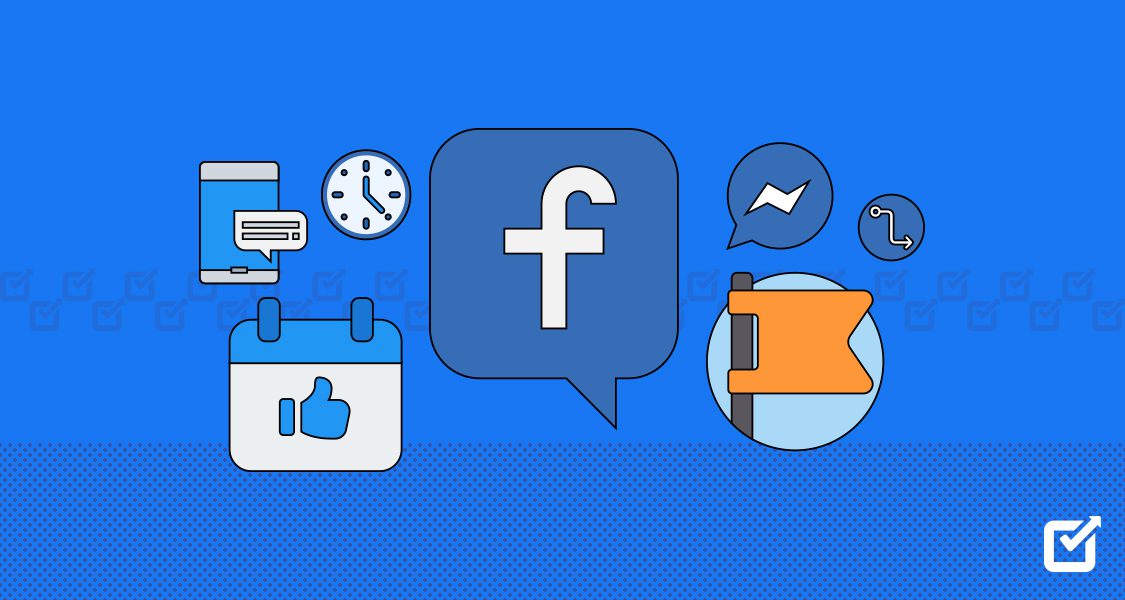

1 comment
Nicole Charles
Seems a great insight, had no idea best time is actually a concept. On my way to integrate so in my LinkedIn strategy.